About the Riedmann Family Crest and Coat of Arms
Coats of Arms date back to the Middle Ages. In those times they were a form of heraldry, which identified a soldier as a member of a particular family. A portion of the Coat of Arms, which was at the top of the emblem, was called the Crest. The Crest was typically worn on top of a helmet. The crest would be a simple design. They could also be found made of leather and other materials and placed on shields and other parts of a uniform or battle gear. Crests would include animals such as lions or great birds giving a specific meaning. Germanic, English, as well as some other European countries, have a great history of Coats of Arms. More information can be found here. Most American families emigrated here from other parts of the world that may have had a Coat of Arms in their past, but it is not as common as many think. As in the past, this provides a military unit or sports fans a form of identification and unity to their institution. Coats of Arms are still common today and can be seen in military units and sports teams for example. In a few countries such as England, they are regulated and their usage can be limited if you do not possess the right to it.
There are four known Riedmann Coats of Arms. Which is the most likely Coat is up for discussion. Below are the four Coats of Arms with a description of each.
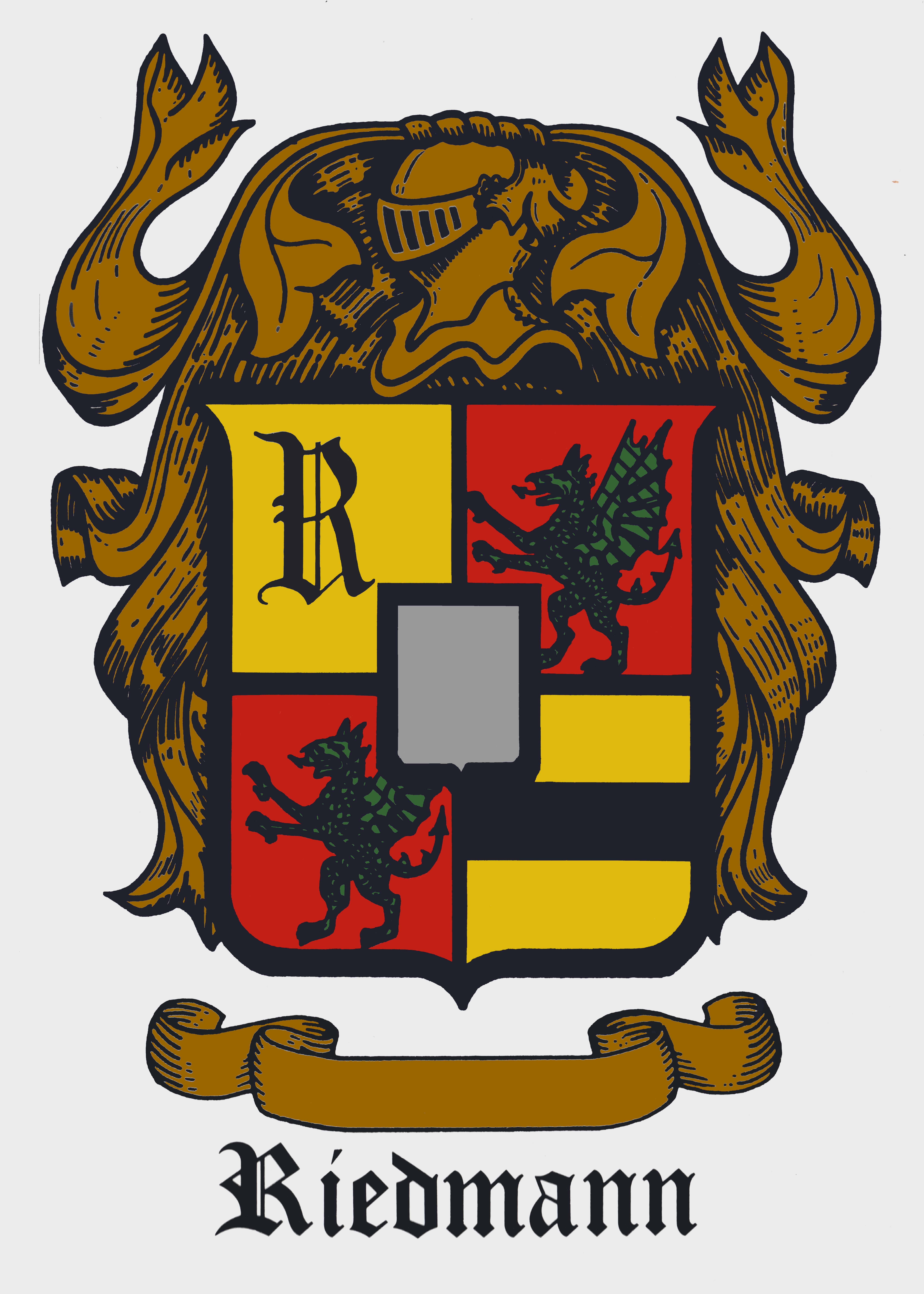
Lou’s Crest:
The image you see above is a Coat of Arms that Lou Riedmann requested several decades back from a genealogical company that said they would research any family name. Below is an explanation of what the colors in the Coat symbolize. This Coat of Arms was emblazoned on the t-shirts given out at the 1992 reunion.
The dragon is symbolic of the defense of treasure. The small inner shield (Escutcheon) is emblematic of a victory over an opponent.
Red – represents fortitude and creative power.
Gold – denotes generosity, valor and perseverance.
Black – (the crossed lines) represents repentance and vengeance.
The middle of the crest is silver which represents serenity and nobility.
The colors of the German flag are Red, Black and Gold which probably explains why the Coat of Arms has these colors.
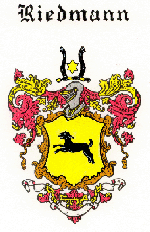
Renie’s Crest:
Above is the Coat of Arms from Renie Van Moorleghem. She said she was ordering a copy of the Van Moorleghem crest and asked the company if they had any information on a crest for the Riedmann Family. This is what she received. (She liked this one better.) The colors have the same meaning as described above.
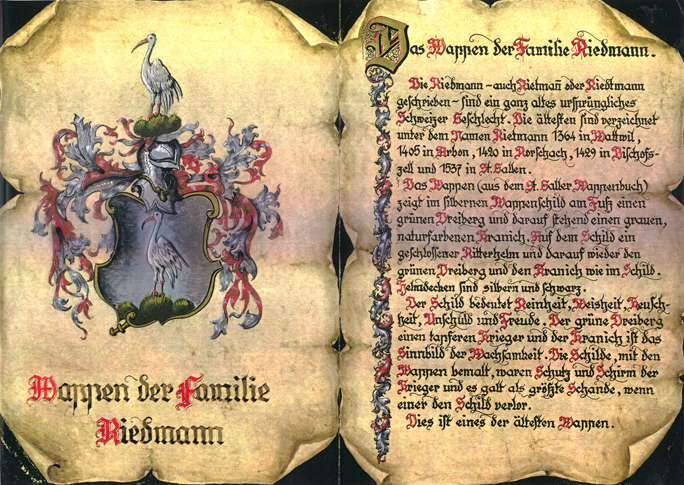
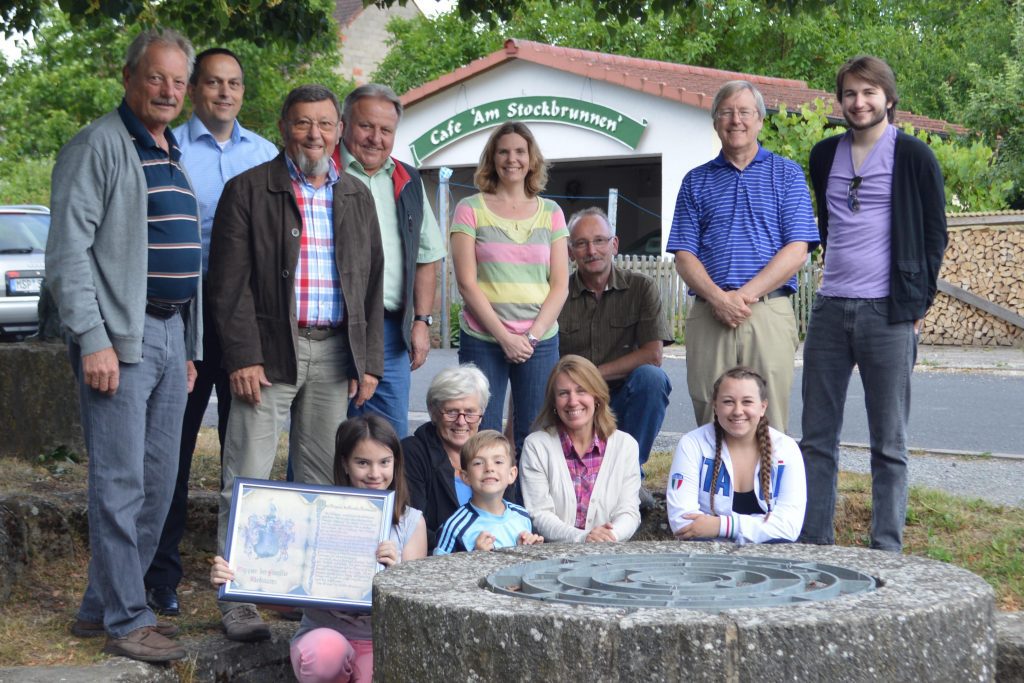
German Crest:
During my visit to Stetten Germany in 2014 I met with Robert Hessdorfer and his family. They had a copy of a Coat of Arms they say has been in the family for many years. It may be the most authentic Coat of Arms. Below is the English and German wording presented with the Coat of Arms.
Note: Sometimes the words Crest and Coat of Arms can be confused in translation. The Crest in this image would be the crane on the top.
English Translation:
The Coat of Arms of the Riedmann family.
The Riedmann – also written as Rietman or Riedtmann – are of a very old origin Swiss linage. The oldest are recorded as the name Rietmann. 1364 in Wattwil, 1405 in Arbon, 1420 in Rohrschach, 1429 in Bischofszell and 1537 in St. Gallen.
The crest (out of the St. Galler book of crests) shows in the silver-colored crest shield at the foot (bottom) green trihill (triple hill) and on top of it a grey, natural-colored crane. On the shield is a closed helmet of a knight and on top of it again the green trihill and the crane as in the shield. Helmet covers are silver and black.
The shield means purity, wisdom, chastity, innocence and joy. The green Trihill is a brave warrior and the crane is the symbol of vigilance. The shields, painted with the coat of arms (crest), were the protection and shield of the warriors and it was considered the greatest shame if someone lost the shield.
This is one of the oldest coats of arms.
German:
Das Wappen der Familie Riedmann
Die Riedmann – auch Rietman oder Riedtmann geschrieben – sind ein ganz altes ursprünglich Schweizer Geschlecht. Die ältesten sind verzeichnet unter dem Namen Rietmann 1364 in Wattwil, 1405 in Arbon, 1420 in Rohrschach, 1429 in Bischofszell und 1537 in St. Gallen.
Das Wappen (aus dem St. Galler Wappenbuch) zeigt im silbernen Wappenschild am Fuß einen grünen Dreiberg und darauf stehend einen grauen, naturfarbenen Kranich. Auf dem Schild ein geschlossener Ritterhelm und darauf wieder den grünen Dreiberg und den Kranich wie im Schild. Helmdecken sind silbern und schwarz.
Der Schild bedeutet Reinheit, Weisheit, Keuschheit, Unschuld und Freude. Der grüne Dreiberg einen tapferen Krieger und der Kranich ist das Sinnbild der Wachsamkeit. Die Schilde, mit dem Wappen bemalt, waren Schutz und Schirm der Krieger und es galt als größte Schande, wenn einer den Schild verlor.
Dies ist eines der ältesten Wappen.
Additional Information:
The Abbey Library of Saint Gall (German: Stiftsbibliothek) is a significant medieval monastic library located in St. Gallen, Switzerland. In 1983, the library, as well as the Abbey of St. Gall, were designated a World Heritage Site, as “an outstanding example of a large Carolingian monastery” and was, since the 8th century until its secularisation in 1805, one of the most important cultural centres in Europe. The library collection is the oldest in Switzerland and one of the earliest and most important monastic libraries in the world. The library holds almost 160,000 volumes, with most available for public use.
St. Gallen, Stiftsbibliothek, Cod. Sang. 1084:
Brief characterization: Coat of arms book of the St. Gallen abbot Ulrich Rösch (1463-1491) with 1,626 coat of arms of secular and spiritual people, especially from southern Germany. The coat of arms book was probably made in the workshop of Hans Ingeram in Heidelberg for an unknown client between Neckar and the Upper Rhine. The St. Gall abbot Ulrich Rösch bought the volume in the 1480s and added numerous coats of arms from the Swiss and bordering German regions to the back, which he had drawn by the Winterthur painter Hans Haggenberg. One of the most important coat of arms books of the 15th century. (smu)
Standard description: Scherrer Gustav, index of the manuscripts of the Abbey Library of St. Gallen, Halle 1875, p. 401.
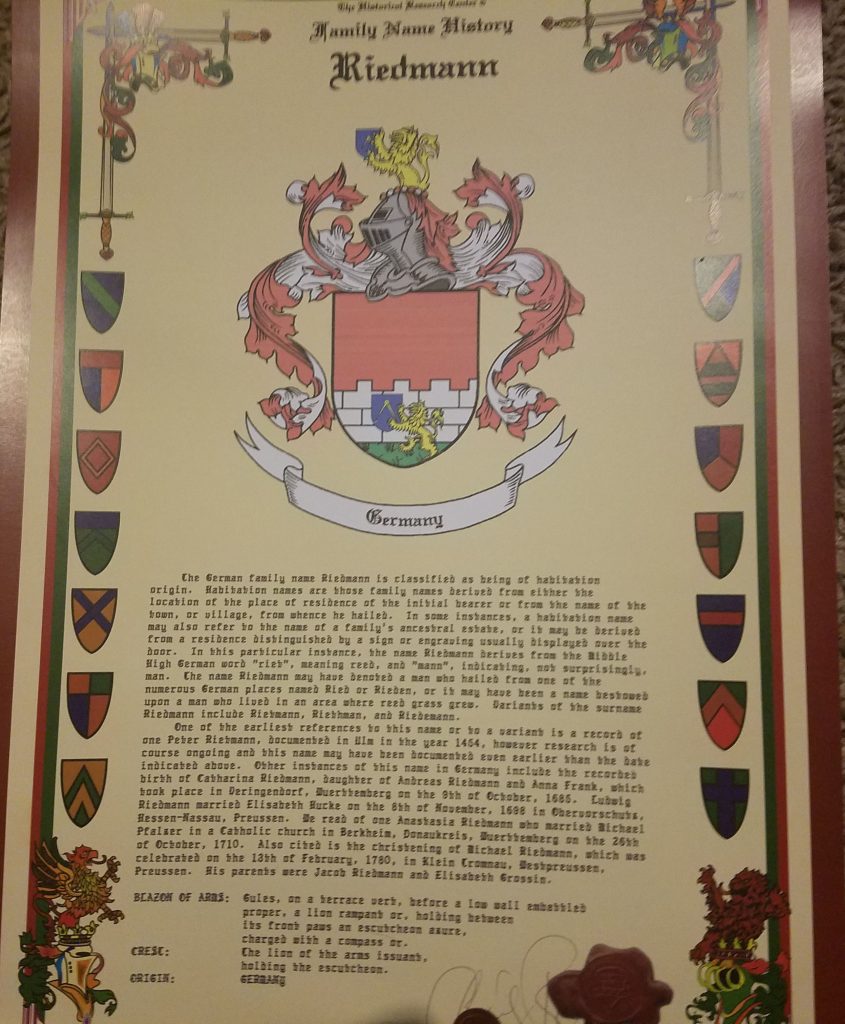
Coat of Arms can also be ordered from companies that specialize in creating them. Above is an example of one found by Chip Riedmann. Its authenticity is unknown.
The crest and crowning of all good, life’s final star, is brotherhood. – Edwin Markham